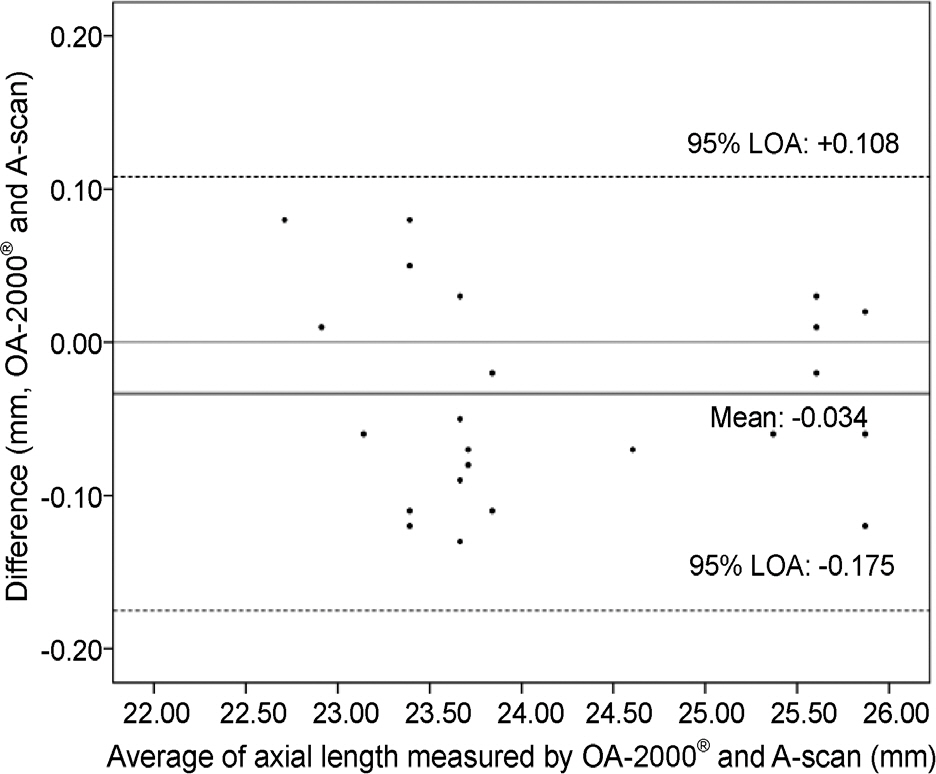J Korean Ophthalmol Soc.
2017 Jan;58(1):43-49. 10.3341/jkos.2017.58.1.43.
Comparison of Biometric Measurements and Refractive Results among Low-coherence Reflectometry, Partial Interferometry and Applanation Ultrasonography
- Affiliations
-
- 1The Institute of Vision Research, Department of Ophthalmology, Gangnam Severance Hospital, Yonsei University College of Medicine, Seoul, Korea. shadik@yuhs.ac
- KMID: 2367840
- DOI: http://doi.org/10.3341/jkos.2017.58.1.43
Abstract
- PURPOSE
To compare the measurement results and the accuracy of the predicted refractive error after cataract surgery among 3 ocular biometry devices; OA-2000®, IOL Master® and A-scan ultrasound in posterior subscapular cataracts.
METHODS
Biometry measurements including axial length, anterior chamber depth and the keratometry of 80 cataractous eyes were measured using ultrasonography, OA-2000® and IOL Master®. To calculate the intraocular lens (IOL) power, the SRK/T formula was used and 3 months after cataract surgery, the refractive outcome was compared to the preoperatively predicted refractive error.
RESULTS
The number of eyes measured by the 3 devices (A-scan, IOL Master® and OA-2000®) was 57 (group A) and the number of eyes measured by 2 devices (A-scan and OA-2000®) was 22 (group B). When cataract grading was performed based on the Lens Opacity Classification system III, the severity of posterior subscapular opacity was significantly different between the 2 groups (p = 0.001). Although no difference was observed in the measured biometry values including axial length, anterior chamber depth and keratometry in groups A and B, the predicted refractive error was significantly different in group B; OA-2000® showed a significantly higher accuracy in predicting IOL power than A-scan.
CONCLUSIONS
In cataract patients whose posterior subscapular opacity is not severe, the accuracy for predicting refractive error after cataract surgery was not significantly different among the 3 devices included in our study (A-scan, IOL Master® and OA-2000®). However, in patients with severe posterior subscapular opacity, OA-2000®, that provides a Fourier domain light source-calculated predicted refractive error of IOL may be more accurate.
MeSH Terms
Figure
Reference
-
References
1. Drexler W, Findl O, Menapace R, et al. Partial coherence inter-ferometry: a novel approach to biometry in cataract surgery. Am J Ophthalmol. 1961; 66:111–24.
Article2. Haigis W, Lege B, Miller N, Schneider B. Comparison of im-mersion ultrasound biometry and partial coherence interferometry for intraocular lens calculation according to Haigis. Graefes Arch Clin Exp Ophthalmol. 1961; 66:111–24.
Article3. Lam AK, Chan R, Pang PC. The repeatability and accuracy of axial length and anterior chamber depth measurements from the IOLMaster. Ophthalmic Physiol Opt. 1961; 66:111–24.4. Wylę gał a E, Teper S, Nowiń ska AK, et al. Anterior segment imag-ing: Fourier-domain optical coherence tomography versus time-domain optical coherence tomography. J Cataract Refract Surg. 1961; 66:111–24.5. Tang M, Wang L, Koch DD, et al. Intraocular lens power calcu-lation after previous myopic laser vision correction based on cor-neal power measured by Fourier-domain optical coherence tomography. J Cataract Refract Surg. 1961; 66:111–24.
Article6. Moon JS, Shin JA, Bae GH, Chung SK. Comparison of biometric measurements and refractive results between applanation ultra-sonography and three different interferometries. J Korean Ophthalmol Soc. 1961; 66:111–24.
Article7. Chylack LT, Wolfe JK, Singer DM, et al. The lens opacities classi-fication system III. The Longitudinal Study of Cataract Study Group. Arch Ophthalmol. 1961; 66:111–24.8. Retzlaff JA, Sanders DR, Kraff MC. Development of the SRK/T intraocular lens implant power calculation formula. J Cataract Refract Surg. 1961; 66:111–24.
Article9. Srivannaboon S, Chirapapaisan C, Chonpimai P, Loket S. Clinical comparison of a new swept-source optical coherence tomog-raphy-based optical biometer and a time-domain optical coherence tomography-based optical biometer. J Cataract Refract Surg. 1961; 66:111–24.
Article10. Telenkov SA, Mandelis A. Fourier-domain biophotoacoustic sub-surface depth selective amplitude and phase imaging of turbid phantoms and biological tissue. J Biomed Opt. 2006; 11:044006.
Article11. Povazay B, Hermann B, Unterhuber A, et al. Three-dimensional optical coherence tomography at 1050 nm versus 800 nm in retinal pathologies: enhanced performance and choroidal penetration in cataract patients. J Biomed Opt. 2007; 12:041211.12. Grulkowski I, Liu JJ, Zhang JY, et al. Reproducibility of a long-range swept-source optical coherence tomography ocular biometry system and comparison with clinical biometers. Ophthalmology. 1961; 66:111–24.
Article13. Grajciar B, Pircher M, Hitzenberger CK, et al. High sensitive measurement of the human axial eye length in vivo with Fourier domain low coherence interferometry. Opt Express. 2008; 16:2405–14.
Article14. McAlinden C, Wang Q, Pesudovs K, et al. Axial length measure-ment failure rates with the IOLMaster and Lenstar LS 900 in eyes with cataract. PLoS One. 2015; 10:e0128929.
Article15. Kim SI, Kang SJ, Oh TH, et al. Accuracy of ocular biometry and postoperative refraction in cataract patients with AL-Scan(R). J Korean Ophthalmol Soc. 1961; 66:111–24.16. Shin JW, Seong M, Kang MH, et al. Comparison of ocular bio-metry and postoperative refraction in cataract patients between Lenstar(R) and IOL Master(R). J Korean Ophthalmol Soc. 1961; 66:111–24.17. Hoffer KJ, Shammas HJ, Savini G. Comparison of 2 laser instru-ments for measuring axial length. J Cataract Refract Surg. 1961; 66:111–24.
Article18. Stattin M, Zehetner C, Bechrakis NE, Speicher L. Comparison of IOL-Master 500 vs. Lenstar LS900 concerning the calculation of target refraction: A retrospective analysis. Ophthalmologe. 2015; 112:444–50.
- Full Text Links
- Actions
-
Cited
- CITED
-
- Close
- Share
- Similar articles
-
- Comparison of Biometric Measurements and Refractive Results between Applanation Ultrasonography and Three Different Interferometries
- Comparison of Ocular Biometry and Postoperative Refraction in Cataract Patients Between Lenstar(R) and IOL Master(R)
- The Accuracy of Axial Length Measurement Using Partial Coherence Interferometrys
- Biometry with Partial Coherence Interferometry and Ultrasonography in High Myopes
- Accuracy of Biometry and Intraocular Lens Power Calculation With Partial Coherence Interferometry in High Myopia




